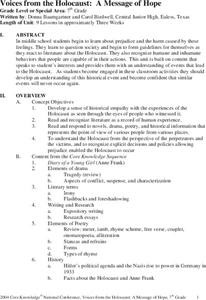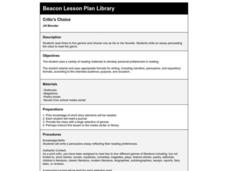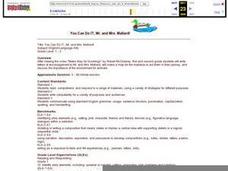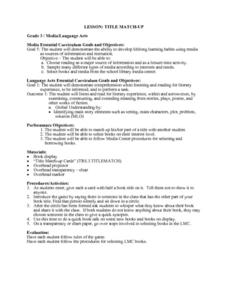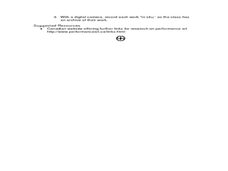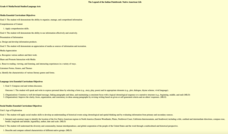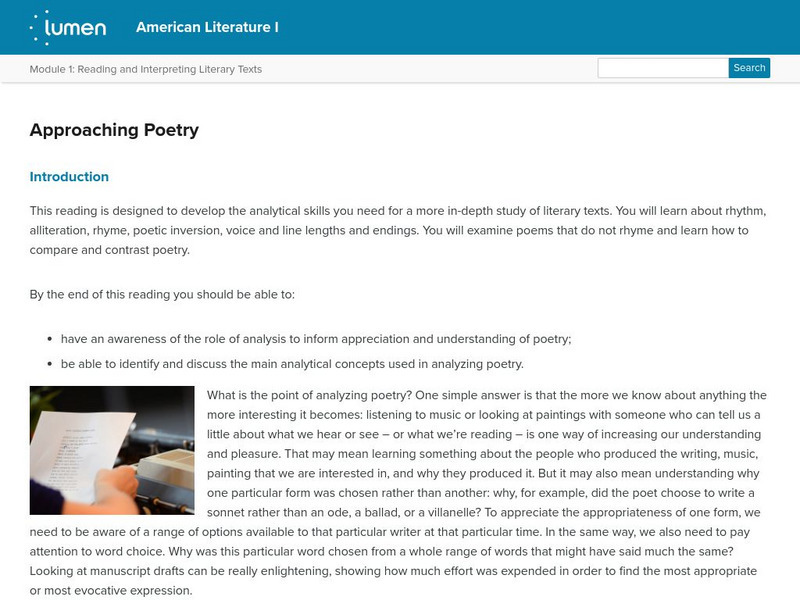Curated OER
Alice's Adventures in Wonderland and Through the Looking-Glass Questions
In this reading comprehension worksheet, students respond to 9 short answer and essay questions based on Lewis Carroll's Alice’s Adventures Through the Looking Glass.
Curated OER
Coyote and Anansi
Students explore the structure of folktales. In this coyote and Anansi lesson, students discuss the attributes of folktales as they read versions of tales featuring coyote and Anansi. Students collaborate to write and perform their own...
Curated OER
Enrichment Activities - "Mrs. Frisby and the Rats of NIMH"
Fifth graders read the novel "Mrs. Frisby and the Rats of NIMH." They discuss the various characters in the book, and the different types of conflict that take place within the book. They also research owls and rats to make comparisons...
Curated OER
Voices from the Holocaust: A Message of Hope
Students develop a sense of historical empathy as they discuss The Holocaust and roll play activities designed to highlight prejudice in today's society. In this Holocaust history and The Diary of Anne Frank lesson, students...
Curated OER
Making Blood!
students research blood's components, and use their math skills to recreate a model of whole blood using commonly found food items.
Curated OER
Critic's Choice
Third graders read three to five genres and choose one as a favorite. They write an essay persuading the class to read the genre. This lesson serves as a nice introduction to different styles of literature.
Curated OER
The Art of Paraphrasing
Tenth graders participate in an activity in which they practice paraphrasing sections of primary and secondary documents. They are to share their paraphrasing with the class to help with their confidence speaking in front of a group.
Curated OER
Landscapes
Learners explore landforms and landscapes. They demonstrate an appreciation for and examine how to recognize the attributes of landforms and landscapes. Students create a landscape and reflect on their painting.
Curated OER
Story Parts
Third graders identify the three major parts of a story. After reading the book "Stellaluna," students discuss the beginning, middle and end of the story. They write a short story depicting the events that would happen if the story...
Curated OER
You Can Do It, Mr. And Mrs. Mallard!
Students watch the video "Make Way for Ducklings" by Robert Mc Closkey. They write letters to Mr. and Mrs. Mallard and make a map for the mallards. They talk about the importance of animal habitats.
Curated OER
Collaborative Book Club Groups
Students participate in book club forums where they write descriptive, evaluation, analysis, synthesis, or inference essays. They take on the role of a character in their bok and publish a web page.
Curated OER
Where Am I? Determining Relative Location
Students use position words to describe where their teacher is sitting and read a story that makes use of position words. In this spatial instructional activity, students make a stick puppet and play Simon Says focusing on using position...
Curated OER
Title Match-Up
Third graders are introduced to a game in which each card they receive will have half of a book title on it. They find the person who has the other half of the title and they sit down in a circle. Students when whisper what they know...
Curated OER
One With Nature
Students discover the connection between Japanese art and Romantic literature using a variety of sources and the impact of nature on these two art forms. This lesson plan is a three-day exploration.
Curated OER
Responding: "Guerrilla" Art
Eighth graders examine a new kind of art that is used to respond to political and social issues. Using primary source documents, they read examples of how others have responded to various issues in the past. Individually, they create...
Curated OER
The Legend of the Indian Paintbrush: Native American Life
Pupils read," The Legend of the Indian Paintbrush" by Tomie dePaola and discuss the way legends are passed down orally. They then create their own legend and illustrate it on a simulated "Buffalo Skin" made from brown paper.
PBS
Pbs Learning Media: Literary Elements and Techniques Collection
These animated shorts introduce or review literary elements and techniques like theme, setting, figurative language, characterization, and conflict. They can be used when students are just learning how to identify the most commonly used...
Lumen Learning
Lumen: Reading and Interpreting Literary Texts: Approaching Poetry
This instructional activity focuses on the how to approach the analysis of poetry. It provides a series of student activities such as having students read and compare a draft and the final version of William Blake's "Tyger" which is...
PBS
Pbs Learning Media: Elements of Poetry
Discover how literary techniques like figurative language, imagery, and symbolism contribute to the overall meaning of a poem. Explore how a poet establishes and builds on a theme and the difference between tone and mood. Through a close...
Georgia Department of Education
Ga Virtual Learning: The Elements of Poetry [Pdf]
This is a 2-page PDF of a chart that lists eight elements of poetry, questions to ask concerning each element, and tips and explanations to aid the understanding of each element. RL.9-10.5 text structure effects
Annenberg Foundation
Annenberg Learner: Literary Visions
Twenty-six half hour videos on literary analysis for high school students that feature authors, scholars, actors and noted critics. Topics include The Art of the Essay, Setting and Character in Short Fiction, Responding to Literature and...
Texas Education Agency
Texas Gateway: Understanding and Analysis of Literary Text: Meter and Rhyme
OnTRACK English II Reading, Module 3, Lessons 1-12, and Practice Lessons 1-3. Students understand, make inferences and draw conclusions about the structure and elements of poetry, drama, fiction, and literary non-fiction, and provide...
PBS
Pbs Learning Media: Literary Elements and Techniques: Imagery
Explore the literary technique of imagery to see how sensory language contributes to the meaning and feeling of a poem in this animated video [1:23] from WNET. Discussion questions below help students to further apply their understanding...
PBS
Pbs Learning Media: Literary Elements and Techniques: Tone and Mood
Explore the difference between tone and mood in this animated video [2:28] from WNET through definitions and examples from poetry and prose. Discussion questions below help students to further apply their understanding before analyzing a...





